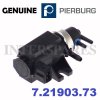ursinecotcher
New Member
It's running absolutely fine with the new pump btw. Happily revving up in all gears and reaching a most definitely legal 70mph with ease.
It's running absolutely fine with the new pump btw. Happily revving up in all gears and reaching a most definitely legal 70mph with ease.



Hello friend you have freelander 2 too? same car?I had the same problem, starting with the same split hose, and I was pulling a caravan at the time.
I replaced the Turbo Boost Solinoid and the MAF as well.
I checked all the joints on the hoses (now replaced) and it runs sweet, pulling lots of weight up really steep hills in 5th with ease.
I bought all the spares on Ebay, and still do.View attachment 145491 View attachment 145492 View attachment 145493
Hi friend , finally i was to Land Rover service and it found the first hose from intercooler was splited...so strange no noises no smoke ...and my error was only when was driving...only then...was fantastic but finaly have resolve the problem....i m so proud car is running now wellI had the same problem, starting with the same split hose, and I was pulling a caravan at the time.
I replaced the Turbo Boost Solinoid and the MAF as well.
I checked all the joints on the hoses (now replaced) and it runs sweet, pulling lots of weight up really steep hills in 5th with ease.
I bought all the spares on Ebay, and still do.View attachment 145491 View attachment 145492 View attachment 145493
Hi,now i have another problem after i fix the hose from throtlle body to intercooler(that was splited) but now i have same problem(power engine reduced with p0299 turbo error) but only over when i m runing over 110 km/h ... i change till now - dpf presure sensor,temperature sensor,recon turbo,maf sensor,lambda sensor,egr check,throtlle body check....i dont know what to seek anymore...any ideas?
My car did the same as yours on the motor way only that now the engine won’t turn over and the AA says the engine has seized. An independent click a Machanic came out to my home and turn the key but nothing. He did the same as the AA man. He did not take out anything or try to turn the car over manually. However, I am getting mixed messages about purchasing another engine without really knowing if the engine has really seized. Any advice welcome.Hello all, just thought i'd update you on the cause of my lack of power issues with my Td4 03MY in case it helps anyone.
I initially had a split turbo hose whilst on the M6. It was the short 90 deg hose. Symptoms were initially lack of power, and then black smoke and air whistling sounds. Bought a new one of those for under a tenner and fitted it.
Unfortunately it didn't fix the lack of power over 70mph, but at least there was now no smoke. Symptoms now were that on a slight gradient on the motorway the car would start to lose power and thus speed. There was also a slight noise but not the same as the air noise from the split before.
The Td4 turbo is variable geometry and is controlled by the boost solenoid (see black plastic unit in the picture). It applies a vacuum to the turbo via pipe 1 in the photo. When the vacuum is applied the turbo exhaust side vanes close and it uses more exhaust gas to provide more boost.
My solenoid had failed so that it constantly applied vacuum to the turbo, and thus operated it at max boost all of the time. What then happens is that when you get a high speed / load condition i.e. 70mph and a hill, the ecu senses that the turbo is over boosting and derates the engine by cutting the fuel in order to protect it from damage. It will then speed up again when you get back onto the flat.
The solenoid is STC4198, cost £34, took 15mins to fit (don't need undertray off). Fitted and all working perfectly now.
So if you have lack of power on hills at 70mph, try this test. Pull pipe 1 off the turbo and drive a 70mph hill and see if it cures your issue. If it does, voila it's the boost solenoid. With the pipe off it will be a little sluggish at low speed accels as it won't be able to close the vanes for full boost, but it's fine to drive in order to do your 70mph test.
For info pipe 1 is solenoid vacuum to turbo, pipe 2 is vac supply to solenoid from the plastic reservoir at the side of the engine, pipe 3 is the solenoid vent to fresh air via the little filter. Check these for holes as they rub various engine parts. Also worth checking that your boost solenoid filter isn't blocked, as this would prevent the solenoid from releasing the vacuum and cause the same symptom. Fair chance it's ok though and your solenoid is bust.
Good luck !
My car did the same as yours on the motor way only that now the engine won’t turn over and the AA says the engine has seized. An independent click a Machanic came out to my home and turn the key but nothing. He did the same as the AA man. He did not take out anything or try to turn the car over manually. However, I am getting mixed messages about purchasing another engine without really knowing if the engine has really seized. Any advice welcome.
No calibration needed. Just remove old one and replace with new. 15 mins topsWell I was lead to believe putting a new solenoid might need calibration somehow with the turbo vnt. Is this a little bit true or was that another rip off attempt from garage?